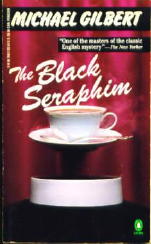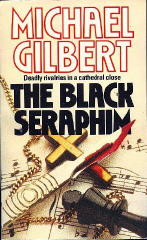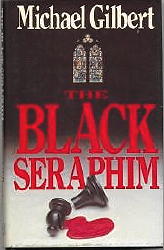Sat 14 Jul 2007
MICHAEL GILBERT – The Black Seraphim
Penguin; US paperback reprint; 1st printing, 1985. Hardcover editions: Hodder & Stoughton (UK), 1983; Harper & Row (US), 1984.; Detective Book Club, n.d. [3-in-1]. Other paperbacks: Hamlyn (UK), 1984; Mysterious Press (US), 1987.

Mr. Gilbert was born in 1912, which would have made him 73 when this book was first published, and by no means was he finished as a writer. By my count there have been 14 more novels and collections that came after this one, including the provocatively titled The Mathematics of Murder, a collection of short stories that was published in England in 2000. No US edition seems to have been forthcoming, and [at the time I write this] no copies of any persuasion show up on ABE at all.
The series characters in The Mathematics of Murder belong to the London solicitors’ firm of Fearne and Bracknell, with several of the stories being previously published in Ellery Queen’s Mystery Magazine, and that is where perhaps they might be most easily tracked down. There are no series characters in The Black Seraphim, to which I will return to in a moment, but over the years several detectives and other starring characters have made their way in and out of Gilbert’s novels and short stories. These include Inspector Patrick Petrella, Inspector (later Superintendent) Hazlerigg, Commander Elfe, solicitor Henry Bohun, Jonas Pickett, the espionage team of Samuel Behrens and Daniel John Calder (Petrella, Pickett and and Elfe also make various crossover appearance in several of their adventures), and Luke Pagan, about whom I know little, but whose cases seem to all have taken place around the time of World War I.
Gilbert’s most recent book is a collection of short stories, The Curious Conspiracy and Other Crimes, which was published by Crippen & Landru in 2002. (C&L also did The Man Who Hated Banks And Other Mysteries, which came out in 1997.) The most recent novel that Gilbert has written seems to have been Over and Out (Hale, 1999), a Luke Pagan entry. Going back to the beginning of his career, Gilbert’s first work of crime fiction was Close Quarters (1947), a mystery in which Hazlerigg has the starring role, a work of detective fiction which falls, definitely and definitively, within the so-called “Golden Age” or classical tradition.
Which gets us circled back around to The Black Seraphim, which – if you’re still with me — is a “Golden Ager” as well, at least in an modernized sense. The romance that’s involved is a little more amorous than it would have been in 1933, for example, and in a few other ways which involve how the story itself is allowed to develop, which I’ll get back to in a moment.

From the beginning, though, while the year this novel takes place is not stated in any specific fashion, it can easily be assumed to be 1983, the year of its publication. Nothing overtly suggests otherwise. But taking place as it does in a small cathedral town, with much of the action behind the walls of the cathedral grounds and in effect isolated within, the book produces the feeling that a massive slidestep back into time has occurred. Save for a few modern conveniences, the year could have as easily been 1933, a mere fifty years before.
James Scotland, a young pathologist sent to Melchester for a little R&R (rest and recovery), soon discovers that jealousies and bitter rivalries can exist (nay, thrive!) just as well in a theological college as well as it can in academia, to name another scene of the crime where the stakes are as equally high (or low, depending on your point of view). Town and gown antagonisms are an equally crucial part of the mix.
Having not read Gilbert recently, if ever, other than one or two short stories, I was surprised a bit at the elements of rowdy schoolboy humor – I’d have thought it was more in Michael Innes’s field of expertise, if you’d asked me ahead of time – but when the murder occurs, it becomes clear that a serious turn has been taken.
And being a book produced later in Gilbert’s career, it is not too surprising that within its pages he turns philosophical, as age and wisdom come upon him, and it is here where I believe the major deviation from the Golden Age comes in.
I hope you don’t mind a lengthy sort of quote. This is from page 182, and is a discussion between Scotland and a lady whom he is rapidly becoming fond of. They are discussing how the investigation is proceeding, and Scotland speaks first:
“About what?”
“Surely you can’t have forgotten. What you said when we were on that walk. About scientists prying into matters they ought to leave alone and coming up with the wrong answers. They came up with the right answer this time.”
This was rash of him. Amanda said, “You’ve got it all wrong, Buster. What I said was that scientists never know when they’ve reached the place where they ought to stop. Well, you’ve reached it now, haven’t you?”
“I doubt if there’s much more information to be extracted from those samples.”
“Right. So you stop.”
“Your father wouldn’t agree with you. He said, ‘When once you have put your hand to the plow, turn not back.’”
“Exactly,” said Amanda triumphantly. “But when you’ve reached the end of the last furrow, you’ve got to stop. You don’t want to start plowing up the road.”

This is not your usual lovers’ tiff, I think you will agree. There are two brief scenes (pages 184 and 191) that puzzlingly do not seem to fit in with any of the explanations that come later, but what at first is the most – let’s say disconcerting – is that the final unraveling takes place totally outside of Scotland’s presence. It’s anti-climactic, one thinks, initially, and then, given some thought, perhaps not.
Much is made of Scotland’s age. He’s but 24, and he’s young enough to recover from the blows of fate that his stand (see above) has dealt him. In what may be a final twist, not in terms of solving the case, but rather in terms of who –- it is another man, not Scotland but one much older, who, in the final few pages, looks back, and who decides on his own that justice has been done, and on its own merits.
It took me a while, but I finally came around. This is a fine piece of work.
PostScript: The title is taken from a line in a poem by the French poet Alfred de Musset, concerning the concept of a blessed wound, from which at length Scotland will recover: “une sainte blessure; que les noirs séraphins t’ont faite au fond de coeur.”
UPDATE [07-14-07] Michael Gilbert died in 2006, nearly two years after this review was written. For a comprehensive online overview of his career, including a bibliography of his mystery fiction, this webpage will do very nicely, I think.